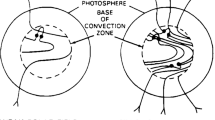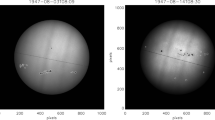Abstract
The seasonal variation of the geomagnetic activity shows two sharp maxima (in March and September) and two broader minima (in June and December). It can only poorly be described by a double sine wave.
The double phase wave of geomagnetic activity can be transformed - by vertical mirroring of the half year part between the maxima - into a single phase wave, which is represented well by a single sine function.
This function is determined here for C i (the daily international character figure of geomagnetic activity) and for A p (the equivalent daily amplitude, based on K p, the geomagnetic planetary three-hour-range indices), for both in their ratios to the mean value over the year and then averaged over many years. To remove part of the irregularities the daily values of C i and A p were corrected for solar activity and reduced to quiet Sun circumstances.
Mirroring back to the double phase function the geomagnetic variation is then represented by
, in which m means the mirror value, A is the amplitude of the single sine curve, λ runs parallel to the Sun's longitude, ϕ is the phase constant and the bars indicate the absolute value.
The data of the first maximum of the seasonal variation was found to vary between March 18 and 28 for different groups of years.
The sharpness of the maxima may point out a resonance in the interaction between the solar wind and the magnetosphere.
In the appendix the relation \(Ci = aR^{{1 \mathord{\left/ {\vphantom {1 2}} \right. \kern-\nulldelimiterspace} 2}} + b\) (R being the relative sunspot number) is brought forward. The values of the parameter b through the eleven-year period reveal an increasing influence of sunspot-free regions towards the minimum.
Similar content being viewed by others
References
Bartels, J.: 1963, Ann. Geophys. 19, 1.
Poulakos, C. and Tritakis, B.: 1972, First European Astronomical Meeting, Athens.
Roosen, J.: 1966, Bull. Astron. Inst. Neth. 18, 295.
Siebert, M.: 1970, Z. Geophys. 36, 41.
Siebert, M.: 1971, Handbuch der Physik ZLIZ/3, Geophysik III/3, p. 206, Springer.
Xanthakis, J.: 1969, Solar Phys. 10, 168.
Xanthakis, J. J.: 1970, in C. J. Macris (ed.), Physics of the Solar Corona, Reidel Publ. Comp., Dordrecht, p. 179.
Author information
Authors and Affiliations
Rights and permissions
About this article
Cite this article
Houtgast, J., Van Sluiters, A. The representation of the semi-annual variation of the geomagnetic activity by an annual sine wave. Sol Phys 31, 513–524 (1973). https://doi.org/10.1007/BF00152826
Received:
Issue Date:
DOI: https://doi.org/10.1007/BF00152826




